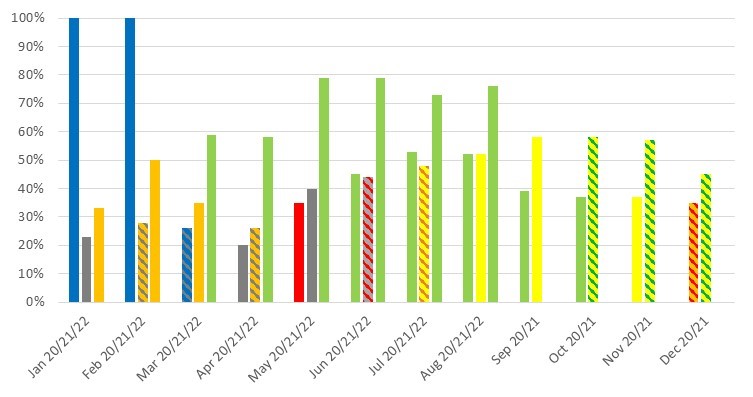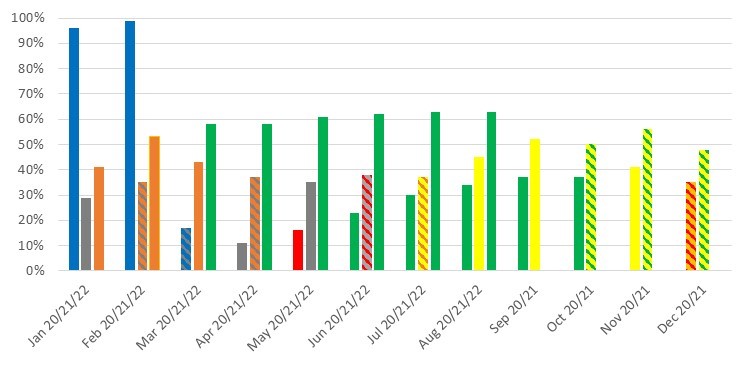Staff Report #3
August 31, 2022
To All Commissioners
Re: COVID-19 Ridership and Service Impacts
Recommendation
The report be NOTED and FILED.
Background
The pandemic declaration in March of 2020 and associated lockdown measures that have followed have resulted in declines in transit ridership on both the conventional and specialized services. Each new wave of the pandemic has resulted in varying levels of public health measures, including lockdowns in some cases. In addition to the impacts on ridership, London Transit has experienced numerous other issues that have impacted the ability to deliver service and work program initiatives as planned.
As the remainder of this report will illustrate, London Transit, consistent with transit systems across the country, finds itself if the eye of a perfect storm. While ridership levels are returning with many buses carrying standing loads, employee resource and supply chain issues are limiting the ability to increase service levels in response. The remainder of the report will discuss each of these elements in greater detail.
Conventional Transit
Ridership
The organizational philosophy adopted at the onset of the pandemic with respect to service levels was to ensure that all areas of the city that were served by transit would continue to be served, albeit at lesser frequencies based on employee resource availability.
The graph below provides an overview of the ridership levels on the conventional service for 2021 and 2022 to date with comparative data for 2020, both as a percentage of what would normally be expected in each month noting the numbers are based on actual boardings as counted by the automatic passenger counters on buses. The bars are coloured to match the various stages of lockdown as noted below:
Green Prevent – no, very limited restrictions in place
Yellow Protect & Stage 3 under the current re-opening plan – very limited restrictions in place
Orange Restrict & Stage 2 under the current re-opening plan – limited restrictions in place
Red Control & Stage 1 under the current re-opening plan – numerous restrictions in place
Grey Lockdown – full lockdown restrictions in place
The colour blue in the graphic is used for January and February 2020 given the pandemic declaration had not occurred at that point in time. Bars that are striped indicate a change during the month from the base colour to the striped colour.
2020, 2021 and 2022 Conventional Transit Weekday Ridership as a Percentage of Normal

The above graph clearly depicts the impacts that the various stages of lockdown have on conventional transit service ridership. As indicated in the graph, weekday ridership in July and August, while dipping slightly which is not unexpected given they are prime vacation season, remained relatively consistent with May and June hovering around the 80% of pre-pandemic levels. It should be noted that this graph is depicting ridership as a percentage of normal in each month, and ridership numbers for the period of May through August are traditionally lower than the rest of the year given the post-secondary students are not attending school during this period. Weekend ridership in July and August continued to surpass pre-pandemic ridership levels for the spring service period, which is problematic given the shortage of resources required to increase service levels.
The next signup period begins September 4, 2022 and runs to November 26, 2022. Effective September 4, 2022, fall service levels will be put in place, including the return of Routes 90, 91, 94, 102, 104 and 106. While it was anticipated that some of the 2021 or 2022 service improvements could also be implemented at this time, the Operator complement has not yet reached the levels required in order to provide additional services reliably. Onboarding of new Operators will continue through the remainder of the year and into 2023 in an effort to reach the complement required to implement the 2021 and 2022 service improvements. These improvements will need to be aligned with signup periods, and will be implemented in a manner that makes the best use of the Operator complement expected to be available at the time.
Employee Resource Requirements – Operations
Work continues with respect to the onboarding of Operators with a class of six recently completing training and a new class of six which began training on August 8, 2022. It is anticipated that classes of six will continue to run throughout the remainder of the year and into 2023. In addition to the need to hire Operators to increase complement, replacements are also required for those that will retire through the remainder of 2022 and in 2023. Additionally, a significant number of Operators will reach milestones in their tenure in 2023 which result in their entitlement to an additional week of vacation. An increase of three Operators to the overall complement will be required in 2023 to cover the lost time associated with the increased vacation entitlement.
Employee Resource Requirements – Fleet and Facilities
There are currently five skilled labour positions and three general service positions open and posted. There are currently no applicants for the skilled labour positions, and administration is in the process of reviewing applicants for the general service positions. In addition to the vacancies resulting from retirement, a number of employees in this department are also off work longer than what would be considered normal, primarily as the result of delays relating to the pandemic. These vacancies and absences have resulted in a significant reduction in available manpower and work is being prioritized in a manner that attempts to ensure that the required number of buses are available for service each day. Administration continues to assess options and implement different approaches in an effort to mitigate any negative service impacts, however the manpower situation is not sustainable and should these complement levels not be addressed through recruitment in the short term the ability to ensure the required number of buses each day for service will be impacted.
Employee Resource Requirements – Administration
Resources in the Administration area have been impacted throughout the pandemic, and were, for the most part managed through re-assignment of duties between roles. While this approach allowed operations to continue without major disruptions, work program initiatives were impacted, in some cases being deferred or delayed indefinitely. Given the small size of many departments, one absence can result in significant disruption, not only within that department, but other departments that may be relied upon to help fill the gap. The current labour market is also placing additional pressure on the administrative area as transit systems and consulting firms are desperately searching for employees at all levels with transit experience. One of the two positions in the payroll department are currently vacant and recruitment is underway however this vacancy will result in other initiatives in the finance area being re-prioritized until such time as the vacancy is filled and the incumbent has been trained.
Supply Chain Issues
Over the past number of months, supply chain issues have, to varying extents, impacted the ability to service and maintain the conventional fleet, the majority of which have been resolved. The most significant issue outstanding is the delivery delay associated with the replacement and expansion buses for 2022, noting the entire order is not expected to be delivered until sometime in 2023. This delay is further compounding the manpower issues identified above noting each bus takes approximately 65 man-hours to be prepared for on-road service once it arrives. Delay of the delivery of the five expansion buses will also have a greater impact on service, as it will limit the ability to implement the 2022 service improvements until such time as the buses have been received and prepped for service.
Specialized Transit
Ridership
The graph below provides an overview of the ridership levels on the specialized service for 2021 and 2022 to date, with comparative data for 2020 as a percentage of what would normally be expected in each month.
2020, 2021 and 2022 Specialized Transit Ridership as a Percent of Normal

As the graph indicates, ridership levels to date for March through August 2022 surpassed the previous pandemic-period high from November 2021. Administration will continue to monitor trip demand by time of day and day of week, and gradually increase service hours to meet demand.
Service
As indicated above, administration is continuing to monitor service demand and will continue to work with the contracted service provider who has struggled with manpower issues, which resulted in the need to cancel daily runs on several occasions in the past few months. Unfortunately cancellations of this nature led to customer trips having to be rescheduled or cancelled, leading to missed medical appointments in some cases. Administration is continuing to work with the service provider to slowly increase service levels as their complement reaches levels they are confident they can maintain.
Corporate Communications
The corporate website, socials and stop-level notices will continue to be utilized, as appropriate, to provide up to date service information including service interruptions, detours etc. to keep customers informed with respect to current issues and plans going forward.
Internally, information screens will continue to be utilized to ensure that employees are informed of the issues being faced and the plans to address them.
As previously mentioned, with respect to vacancies and ongoing recruitment, in addition to advertising on recruitment sites, local radio and London Free Press as well as on the corporate socials and website, consideration for other forms of advertising will continue to be assessed and utilized over the coming months in an effort to fill vacancies.
Recommended by:
Katie Burns, Director of Planning
Mike Gregor, Director of Finance
Craig Morneau, Director of Fleet & Facilities
Joanne Galloway, Director of Human Resources
Concurred in by:
Kelly S. Paleczny, General Manager